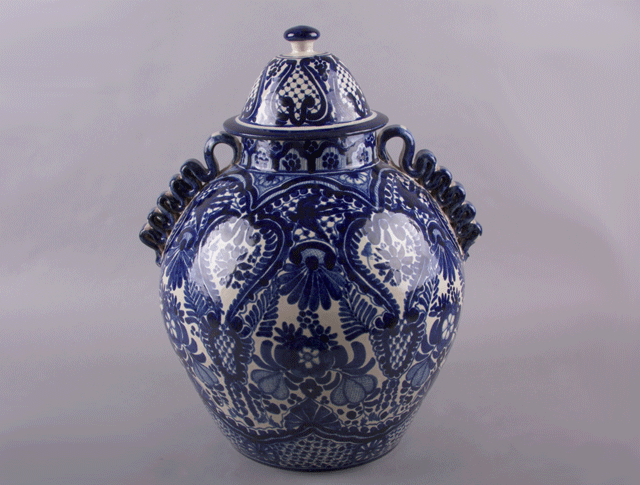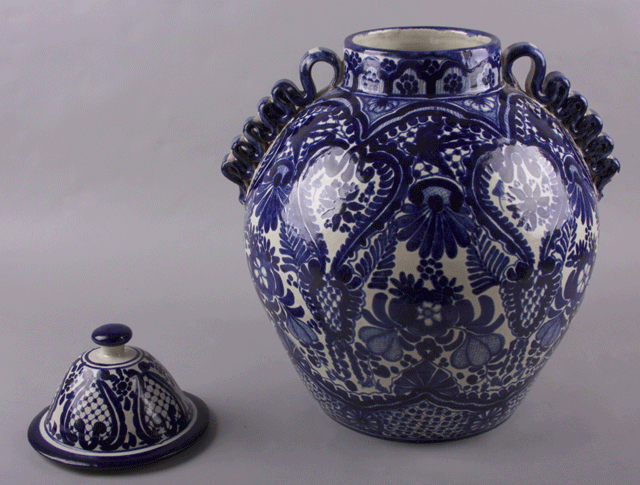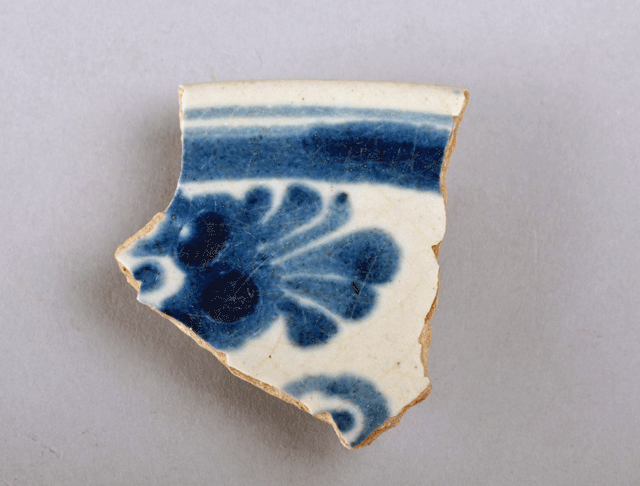
2015.9.2, blue-on-white jar and lid; Mexico, 1900s.
Gift of Leslie G. Cohen; photo by Tom Ocken

2015.9.2, blue-on-white jar and lid; Mexico, 1900s.
Gift of Leslie G. Cohen; photo by Tom Ocken
The blue-on-white pottery shown above is an example of tin-glazed earthenware, or mayólica. In English the name is spelled "mayolica" (no accent), "maiolica," or "majolica," but in each case the pronunciation is the same as in Spanish. Mexican mayolica, still made today, represents artistic influences from two directions. The making of Chinese-inspired blue-on-white pottery spread west through the Arab world to Spain. In turn, the Spanish started producing mayolica in Mexico almost as soon as they had conquered the region, in order to have tablewares like the ones they had used back home. Chinese blue-on-white pieces traveling east across the Pacific Ocean, on the Manila Galleons (as we describe here) influenced the nascent Mexican maiolica industry. The modern urn shown above fuses Chinese ideas (such as the general shape and details of the painting) and Spanish ones (in particular, the ribbon handles), but the resulting combination is uniquely Mexican.
An interesting if minor point about this particular jar is that the body and
lid don't quite match—a fact that's easier to appreciate when they're
seen side by side. We don't know whether the mismatch happened before or after
the jar was first sold.

Photo by Tom Ocken
Mexican mayolica was an important import in New Mexico during the Spanish
Colonial period. The next photo shows a fragment of mayolica found at the
Pueblo village of Ghufoor, also known as Santiago, on the Rio Grande just
south of Bernalillo.

2011.230.36, Puebla blue-on-white potsherd; 1700s.
UNM field acquisition; photo by Tom Ocken
Ghufoor was the Pueblo where Coronado's expedition camped when it first arrived in the Rio Grande Valley in 1540. That fall,when it became too cold to camp in tents, the Spanish drove out the residents of the village and took it over for themselves. Ghufoor was abandoned in the 1600s but Pueblo and Hispanic residents of the area continued to use the area for farming and herding. The mayolica sherd shown above is an example of Puebla Blue-on-white and probably arrived in New Mexico between 1693 and 1800. The dish must have been dropped on the then-defunct village by someone camping there. For a second, almost identical bit of pottery also left at Ghufoor, click here. For an example from San Gabriel de Yunque, New Mexico's first Spanish capital (featured in a different online exhibit), click here.
See source code for copyright information. Page last revised on July 23, 2015. Please report problems to toh@unm.edu